Solar energyis the fastest-growing renewable energy source, accounting for more than 3% of the U.S. electricity supply.
Humans are hoping to create a brighter and greener future. And, understandably, we all want to focus on the many solar energy benefits. Yet, the limitations are rarely discussed.
So what are the negative environmental effects of solar energy? Continue reading to find out.
Energy and Water Demand
Figures show that coal emits 25 times more carbon dioxide than solar energy. Despite that, it’s important to recognize that clean energy such as solar is not perfect.
Solar panels require lots of energy up-front. Mining, manufacturing, and transporting materials are critical steps along the way.
The manufacturing process is relatively energy-intensive. Silicon solar cells are produced from quartz sand in a furnace at high temperatures.
The manufacturing process is water-intensive too. Although, advancements in technology have reduced their use of water. And once installed, the panels need no water to generate electricity.
Homeowners don’t need much water to maintain their panels, but should wash them to improve their efficiency.
Habitat Loss
Another drawback of solar energy is the land lost to larger, utility-scale solar plants. Here, there is lots of potential for environmental degradation.
Solar farms can impact the local fauna and flora, vegetation growth, and damage agriculture. Wind energy can share the land it occupies to generate electricity, but solar cannot.
Creating a large-scale solar farm requires clearing vast amounts of land. This process can cause compression of soil or excessive soil erosion. Drainage channels may also be affected.
It can increase the risk of land, water, and air pollution if health and safety guidelines are not followed.
A few panels on the roof of a house will cause minimal problems. But a huge solar farm can cause various issues to the local environment.
If you’re interested in solar panels for your home, you can estimate the savings you’ll make through www.blueravensolar.com.
Toxic Chemicals
Many hazardous materials are used during the manufacturing process. Hydrochloric acid, sulfuric acid, nitric acid, hydrogen fluoride, and 1,1,1-trichloroethane all pose a risk to workers. Failure to dispose of them properly can be detrimental to all types of living creatures and the local environment.
There are US laws that prevent the dumping of toxic substances. Unfortunately, global manufacturers may not have such strict requirements.
Solar panels don’t produce any emissions through their production of electricity. Yet, carbon dioxide is certainly released, albeit not in large amounts, in the manufacturing, transportation, installation, maintenance, and dismantlement stages.
Looking at the big picture, we must ask ourselves, ‘will solar energy guide us to a better or worse future’?
Now You Know What Are the Negative Environmental Effects of Solar Energy
Now that we answered the question “what are the negative environmental effects of solar energy?” you can see that while solar power may not be perfect, the negative environmental impact is minimal compared to coal and natural gas. Developments in technology make solar an excellent clean energy source. But it’s important not to ignore the environmental issues detailed above.
Did you enjoy this article about the negative environmental effects of solar energy? Well, take a look at more fantastic blogs on our website.

